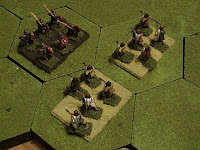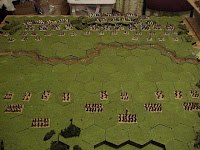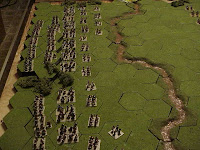
So I've now got the rules for tactical battles written up as well as a system for campaigns (Vini Vidi Vici). I need a way to integrate the boardgame with the miniatures game.
As the picture of the 9 width hex at the left shows, the terrain on the Vini Vidi Vici map is pretty simple- Clear and woods. Rivers and rough terrain are handled on the hex edges instead of the hex itself. How hilly a piece of terrain is determined by how many hexsides have a ridgeline or mountain next to it.
For example, if you look at hex E0608 (the hex with the "Thes" in Thessaly), you will see that the hex is clear terrain with 2 ridgelines. This would equate level 2 rough hex, which effects the density of the hills that can be generated on the tactical map, just as woods terrain would effect the density of woods on the tactical map.
The next step is to figure out how this all equates with the tactical board. I settled on a board that was 17 hexes wide (which gives 9 hexes at each of the 6 edges). This fits almost totally on my 4x4 board space I currently have (there is a little overhang on 1.5 hexes, but that is not too much of a problem).
The hex configuration allows me to randomly determine the set up halves of the board once all the terrain is generated. There are 3 possible axes that result, allowing me to actually use that terrain more than once if desired without having to take the time to regenerate it.
To test the whole tactical battle board out, I created some random charts to create forces of somewhat similiar size and composition, with a little randomness thrown in. The forces that fight will be about the average to small size that would fight in the real game.

Force A (the defender which we'll call the rebels) is composed of 3 regular cohorts, 2 archer auxilia, 3 javelin Auxilia, 1 trained auxilia, 2 levy auxilia, 1 heavy cavalry unit and of course the grizzled army general. The cohorts and the heavy cavalry are the best heavy units, of course, followed by the trained auxilia and the unenthusiastic levy auxilia. All the Roman regulars and the cavalry are treated as drilled (this allows them a little more maneuverability on the battlefield). The trained auxilia is decent, but the levy auxilia will be prone to run away if things get tough.

Force B (we'll call them the "loyalists") is the attacker. It is composed of 2 Veteran cohorts, 2 Levy cohorts, 2 Levy auxilia, 4 Light auxilia, 2 archer auxilia and the loyalist general.

Here is the terrain I generated on the tactical board (I assumed open terrain with no modifiers for hills). The Rebels set up on the left, Loyalists on the right. This is the picture after the 1st move for both sides.
The loyalists had to break the rebel army in about 12 turns (the end is randomized, it could be 12 turns, it could be up to 20 to keep both sides guessing) or they would be the loser and have to retreat from the strategic mapboard.
The Rebels had the advantage of a heavy cavalry unit, while the Loyalists had nothing to counter it with than their more veteran legionaries. The best bet for the Loyalists was to pepper the Rebels with missile fire, waiting for some part of the line to waiver before sending in the heavier troops. The Rebels, however were not going to play that game, being inferior in missile troops and in general quality level. They were going to take the offensive.

The Rebel heavy cavalry (in the lower left corner) charged out and attacked the Loyalist Veteran cohort nearest it, Taking casualities from missile fire but keeping on coming. The veterans broke, and the heavy cavalry looked poised to run over some lighter troops and take the rest of the Roman line in the flank while it was engaging the main Rebel force.

But the stalwart archers kept inflicting losses upon the cavalry, halting their charge and driving them back. In the process they became heroized (a fate condition that allowed them to re-roll 1 failed morale check). The threat was averted !

This is the poor cavalry unit that almost caused so much havoc. I use magnetic movement bases (I base my figures on metal) so that I can lay the my marker washers on the base, instead of on the figure (it helps prevent some wear and tear). It also serves as an easy way to organize and move the figures around the board. As a side bonus, the magnetic bases are color coded (hard to see from this angle, but readily apparent to the players) red and green, so that it is easy to tell which side is which when things get jammed up in melee.

But back to the battle ! At the time of the cavalry charge, the Rebel's main line contacted the Loyalist's main line and a fierce melee ensued. On the Loyalist's right flank (upper left of the picture) the levy infantry chased the Rebel light infantry into the woods and became entangled in a deadly game of cat and mouse.

Against all odds, the Royalist center broke and, despite the setback on the flank (a victory there would've probably won the day for the Rebels), they still seemed poised to win the day.
But again, luck was not with them. The under-appreciated light and archer auxilia held the main thrust up at the cost of blood until the Royalist center could recover. The battle started to turn against them...

The beginning of the end came when 2 Rebel cohorts rolled morale checks of "12" (fate in a bad way in my rules), which meant that they had enough and fled the field. This left 1 cohort with the army general surrounded in the middle of the field. The rebel army was broken- Long live the Royalists !
The game took about 1.5 hours to play and 10 min to set up. It lasted exactly 12 turns before the surrender.
Now to take the result and apply it to the campaign game.
The Loyalists lost about half of a veteran cohort and a levy cohort, as well as 2 light infantry. The archers were beaten up, but survived in a reduced state. Since they won the battle, they could recover some of those losses. I'd flip and remove the appropriate counters from the strategic board and place this army in the hex it has won.
The Rebels lost 2 cohorts, all their levy and most of their light infantry. The cavalry unit survived in reduced form. I'd flip and remove the appropriate counters on the strategic board. Since they lost the battle, they could not recover any of their losses and would have to retreat to an adjacent hex. This will be a much reduced army that would need reinforcements during the next campaign turn.
The side with more cavalry would be able to gain some pursuit bonus (if it won) or possibly recover some of its losses (if it lost). If supply status of the army had to be taken into account, that would affect the general morale levels of the army. A campaign has so many things to take into account, but the meaning of each battle is much richer taken in the context of a well-laid out campaign game.

Here is the one page of charts for my rules, written up as I spoke of in the previous post. The rules are 8 pages long. The Vini Vidi Vici rules are about as long and have a few tables as well.
In conclusion, I think I have the basis for a very easy to control, dynamic campaign game. Now I have to find the players with the time and the desire to give it a try....
 As you can see, I decided to flock the magnets with the finest grain turf I could find (Woodland Scenics). One side is a yellow grass color, the other a soil color. This also allowed me to flock the individual figures with a blended grass color- which I think looks better than the colored bases I was using before. That is also the reason you have to get the strongest magnets you can find ! That extra layer between the metal and the magnet reduces the binding by a lot.
As you can see, I decided to flock the magnets with the finest grain turf I could find (Woodland Scenics). One side is a yellow grass color, the other a soil color. This also allowed me to flock the individual figures with a blended grass color- which I think looks better than the colored bases I was using before. That is also the reason you have to get the strongest magnets you can find ! That extra layer between the metal and the magnet reduces the binding by a lot. All in all, I'm pleased with the results. It provides a terrific flexability in use of figures and rule sets. I've created different size bases depending on the unit and its current size. It also allows me to use troops that would normally be on one side only (e.g. Roman) and use the same troops on the other side (perfect for that Roman Civil War stuff).
All in all, I'm pleased with the results. It provides a terrific flexability in use of figures and rule sets. I've created different size bases depending on the unit and its current size. It also allows me to use troops that would normally be on one side only (e.g. Roman) and use the same troops on the other side (perfect for that Roman Civil War stuff).




 Here is the terrain I generated on the tactical board (I assumed open terrain with no modifiers for hills). The Rebels set up on the left, Loyalists on the right. This is the picture after the 1st move for both sides.
Here is the terrain I generated on the tactical board (I assumed open terrain with no modifiers for hills). The Rebels set up on the left, Loyalists on the right. This is the picture after the 1st move for both sides.















